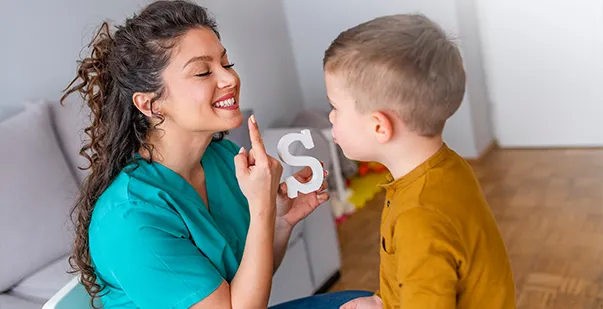Pediatric occupational therapy is all about helping kids master the everyday tasks that make them feel confident and independent. From tying their shoes to writing their name, therapists guide children in developing the skills needed for school, play, and life. Whether it's improving motor skills or boosting social confidence, OT can make a huge difference.
Did you know that one in six children in the U.S. has a developmental disability? Pediatric occupational therapy provides the support these children need to overcome challenges and thrive in their world, one step at a time. So, scroll down and learn more about a pediatric occupational therapist, their job role, state-wise salary and the steps to become one.
Who Is A Pediatric Occupational Therapist?
Some children may struggle with certain activities like eating, writing, playing, and dressing due to medical conditions, injuries, or developmental delays. On average, 2.4% of occupational therapy is used for 3 to 13-year-olds.
Pediatric occupational therapy helps them overcome these difficulties. Therapists design personalized plans to improve the child's abilities to perform activities like playing, dressing up, eating or even writing. Pediatric occupational therapy is beneficial for children with:
Read More: Who Is an Occupational Therapy Assistant
Children Facing Developmental Challenges
Some children take longer than usual to develop motor skills like crawling, walking, or holding objects. They may also have trouble learning how to feed themselves or dress. Therapy helps improve these skills through exercises and activities that strengthen muscles and coordination.
Autism Spectrum Disorder (ASD)
Children with ASD may struggle with communication, social interaction, and daily routines. They might also experience sensory problems, such as sensitivity to loud sounds or particular textures.
Through therapy, they can learn self-care techniques, adapt to sensory events, and enhance their social abilities.
Cerebral Palsy
Cerebral palsy affects muscle movement and strength, making it hard for children to walk, sit, or hold objects. Some children may also have difficulty with balance and coordination. Therapy focuses on improving muscle control, increasing flexibility, and helping children become more independent.
Down Syndrome
Children with Down syndrome may have weak muscles and delayed motor skills, making everyday tasks difficult. They may also need extra help with self-care activities like eating, dressing, and brushing their teeth. Therapy helps strengthen their muscles, improve coordination, and teach daily living skills.
Sensory Processing Disorders
Some children have trouble processing sensory information, making them very sensitive to sound, touch, or movement. Others may not notice sensory input, like pain or temperature changes. Therapy helps them manage their responses and feel more comfortable in their surroundings.
Handwriting Difficulties
Some children struggle to hold a pencil, form letters, or write neatly. This can make schoolwork frustrating and slow. Therapy helps strengthen hand muscles, improve grip, and develop better control for writing and other fine motor tasks.
Injuries Or Birth Defects
Some children are born with physical challenges that affect movement, while others may develop difficulties due to injuries. These challenges can make it hard to perform daily activities. Therapy helps them adapt, regain strength, and learn new ways to complete tasks independently.
Learning Disabilities
Some children have trouble understanding instructions, organizing tasks, or remembering information.
They may struggle with problem-solving and following steps in daily routines. Through cognitive skill improvement, therapy facilitates learning and task completion.
Behavioral or Attention Issues
Some children find it hard to focus, follow rules, or manage their emotions. They can find it difficult to stay motionless or finish chores at home and at school. They gain better self-control, learn how to pay attention, and find it easier to stick to daily activities.
Read More: Building Stronger Bonds: Addressing Challenging Behaviors in Family Dynamics
What Does A Pediatric Occupational Therapist Do?
Pediatric occupational therapists help children develop skills for daily life. They assess a child’s strengths and challenges and create therapy plans based on their needs.
These plans focus on improving movement, thinking, and self-care skills. The goal is to help children become more independent and confident.
Read More: Differences Between Occupational Therapy And Physical Therapy
Fine Motor Skills
Fine motor skills involve small hand and finger movements. Children need these skills for writing, buttoning clothes, and using utensils. Some children struggle with holding a pencil, cutting with scissors, or picking up small objects. Therapists use exercises like drawing, stacking blocks, and squeezing playdough to strengthen hand muscles and improve coordination.
Gross Motor Skills
Gross motor skills involve larger movements of the arms, legs, and body. These skills are needed for activities like walking, jumping, running, and balancing.
Some children may have weak muscles or difficulty controlling their movements. Therapists use activities like obstacle courses, climbing, and stretching exercises to improve strength, coordination, and balance.
Cognitive Skills
Cognitive skills help children think, learn, and remember. These skills include problem-solving, following instructions, and paying attention.
Some children struggle to complete tasks, organize thoughts, or stay focused. Therapists use memory games, puzzles, and structured activities to help children improve concentration and thinking abilities.
Self-care Skills
Self-care skills help children do daily tasks independently. These include dressing, eating, brushing teeth, and using the toilet.
Some children find these tasks difficult due to weak muscles, poor coordination, or sensory challenges. Therapists teach step-by-step methods, use visual aids, and practice routines to help children complete self-care tasks on their own.
Sensory Integration
Sensory integration helps children process and respond to information from their senses. Some children are overly sensitive to sounds, textures, or movements, while others may not respond to sensory input at all.
This can make daily activities overwhelming or confusing. Therapists use swings, textured objects, deep-pressure activities, and movement exercises to help children adjust to different sensory experiences and feel more comfortable in their surroundings.
Read More: What Is Professional Physical Therapy?
What Is The Salary Of A Pediatric Occupational Therapist?
According to the latest salary estimates from ZipRecruiter, the average salary for a Pediatric Occupational Therapist in the United States is around $86,665 per year. However, pay can vary significantly based on the state you work in, with some states offering well above the national average.
Pediatric occupational therapists typically earn between $31 to $47 per hour, depending on experience, location, and type of facility (e.g., schools, clinics, or hospitals). Some states also offer additional perks like relocation benefits, signing bonuses, and better work-life balance, which makes them especially attractive for job seekers in this field.
The top 5 highest-paying states are listed in the table below:
Read More: Advanced Techniques in Physical Therapy Continuing Education Courses
How To Become A Pediatric Occupational Therapist?
Working with children to help them build essential life skills can be a deeply fulfilling career. Here's a simple step-by-step guide on how to enter this rewarding field:
Step 1: Complete a Bachelor's Degree
Start with a bachelor’s degree in a health-related field like psychology, biology, or kinesiology. This gives you the foundational knowledge and prepares you for graduate-level occupational therapy programs.
Step 2: Enroll in an Accredited OT Program
Apply for a master’s or doctoral program in Occupational Therapy accredited by the Accreditation Council for Occupational Therapy Education (ACOTE). These programs usually take 2–3 years and include classroom learning, labs, and hands-on clinical experience.
Step 3: Fulfill Clinical Fieldwork Requirements
During your OT program, you'll complete supervised fieldwork in various healthcare settings. This hands-on training helps you apply your skills with real patients, including children, under professional guidance.
Step 4: Pass the NBCOT Certification Exam
After graduation, you must pass the NBCOT (National Board for Certification in Occupational Therapy) exam. This national certification is essential to become a licensed Occupational Therapist in the U.S.
Step 5: Obtain State Licensure
Each state has its licensing requirements. Submit your NBCOT results and any required documents to your state board. Some states may also require background checks or additional coursework.
Step 6: Gain Pediatric Experience
Work in hospitals, schools, or pediatric clinics to gain specific experience with children. Entry-level roles or internships focused on pediatric care can build your skills and strengthen your resume.
Step 7: Consider a Pediatric Specialty Certification
While optional, certifications like BCP (Board Certification in Pediatrics) show your advanced knowledge in pediatric care. You consider enrolling in such certifications to improve job prospects and stand out in the field.
Read More: The Importance of Continuing Education in Physical Therapy: Why Lifelong Learning Matters
Common Techniques Used In Pediatric Occupational Therapy
Those who take pediatric occupational therapy courses can learn techniques from these courses to help children. These techniques are chosen based on the child’s condition and goals.
Sensory Integration Therapy
Some children are sensitive to sounds, textures, or movements. Sensory integration therapy helps them process and respond to sensory input in a better way. Therapists use swings, textured objects, or deep-pressure activities to help children adjust to sensory experiences.
Hand-Eye Coordination Activities
Hand-eye coordination is very important for tasks like catching a ball, writing or using scissors. Therapists use puzzles, drawing exercises, and bead threading to improve these skills.
Strength And Balance Training
Children with weak muscles or poor balance may struggle with walking, climbing stairs, or playing. Therapists use obstacle courses, jumping activities, and core-strengthening exercises to improve movement and stability.
Daily Living Skills Training
Therapists teach children how to perform everyday activities like tying shoelaces, holding a spoon, or brushing their hair. They use step-by-step instructions and practice sessions to build these skills.
Play-Based Therapy
Play is an important part of a child's development. Occupational therapists use play activities to improve coordination, social skills, and problem-solving abilities. Toys, games, and role-playing activities help children develop important life skills.
Where Does Pediatric Occupational Therapy Take Place?
Pediatric occupational therapy sessions take place in different locations based on the child's needs. The right setting helps the child practice and improve their skills in a comfortable environment. Therapists work with children in hospitals, clinics, schools, and homes to provide the best care possible. Here are some of the places where pediatric occupational therapy takes place:
Hospitals
Some children need occupational therapy while recovering from injuries, surgeries, or serious illnesses. In hospitals, therapists help children regain strength, improve movement, and learn how to do daily tasks again.
They also assist children with medical conditions that affect their ability to eat, dress, or play. Hospital-based therapy focuses on helping children recover and prepare for life at home.
Clinics
Many children visit clinics for regular therapy sessions with trained professionals. Clinics provide a structured environment where children can practice different skills using special tools and equipment.
Therapists work on improving hand movements, balance, coordination, and thinking skills. Children who need long-term therapy often visit clinics to get continuous support and monitoring.
Schools
Some children struggle with classroom activities like writing, focusing, or interacting with others. In schools, occupational therapists help students improve handwriting, attention, and participation in lessons.
They also assist children with using school supplies, organizing their work, and following daily routines. School-based therapy helps children succeed academically and socially.
Homes
Some therapists visit children at home to help them practice daily tasks in a familiar setting. This is useful for children who have difficulty dressing, eating, or following routines.
Home-based therapy allows therapists to work closely with families and teach parents how to support their child's progress. Practicing skills at home helps children gain confidence in their daily activities.
The Impact Of Pediatric Occupational Therapy!
Pediatric occupational therapy helps children learn important skills like playing, communicating, eating, dressing up, reading and writing. It supports children who have trouble with movement, coordination, focus, or self-care. Through fun activities and special exercises, therapists help children become more independent and confident. This therapy can take place at home, in schools, clinics, or hospitals, depending on the child’s needs.
Pediatric occupational therapy not only brings visible improvements in a child’s daily life but also opens rewarding career opportunities, with professionals in this field earning competitive salaries. If you are passionate about making a difference and want a fulfilling, well-paying career, enroll in a reputable occupational therapy course today.




